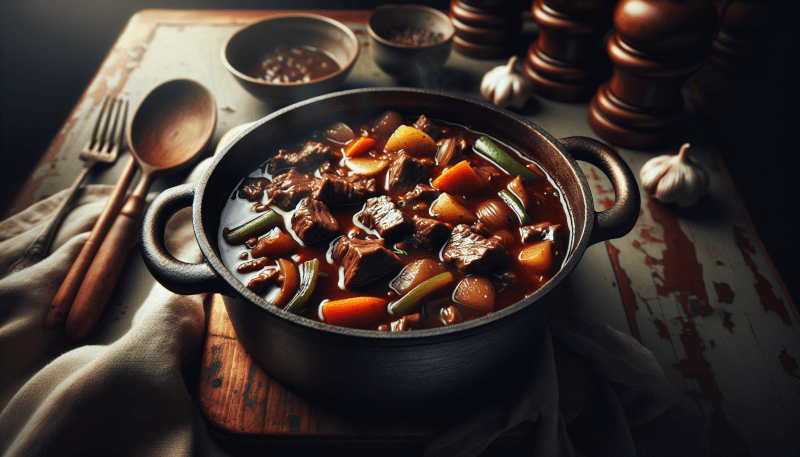Are you ready to warm up your kitchen with the delicious aroma of a hearty beef stew? Look no further because we have got you covered! In this article, we will walk you through the step-by-step process of creating a mouthwatering beef stew in the comfort of your own kitchen. From selecting the perfect cuts of beef to adding the right blend of herbs and spices, you’ll become a stew master in no time. So grab your apron, sharpen your knives, and get ready to savor the comforting flavors of this timeless dish!

Choosing the Right Meat
When making a beef stew, it’s important to choose the right cut of meat to ensure that your stew turns out tender and flavorful. Consider using tough cuts of beef, such as chuck, brisket, or round. These cuts have more connective tissue and marbling, which will break down during the cooking process and add richness to the stew. Avoid lean cuts of beef, as they tend to become dry and tough when cooked for a long time. Instead, opt for cuts that benefit from slow cooking to become tender and succulent.
To further enhance the texture of your beef stew, it’s a good idea to trim excess fat from the meat before cooking. While some fat is necessary for flavor, too much can make the stew greasy and unappetizing. Use a sharp knife to carefully remove any large pieces of fat from the meat. This will also prevent the stew from becoming overly heavy and oily.
Once you have chosen your beef and trimmed excess fat, it’s time to cut the meat into bite-sized pieces. This will ensure that the meat cooks evenly and is easy to eat. Cut the beef into cubes or chunks, depending on your preference. Make sure to remove any tough sinew or gristle as you go. Having uniformly sized pieces of meat will also help the stew to cook more consistently and allow for optimal flavor distribution.
Essential Ingredients
To create a delicious and well-rounded beef stew, you’ll need a few essential ingredients. These ingredients will lend depth and complexity to the stew, making it a flavorful and hearty dish.
First and foremost, you’ll need a base of beef broth or stock. This will form the foundation of your stew’s flavor and provide a savory and rich background to the other ingredients. You can use store-bought beef broth or make your own by simmering beef bones, vegetables, and herbs for several hours.
Next, gather an assortment of vegetables to add both flavor and texture to your stew. Carrots, potatoes, and onions are classic choices that give the stew a comforting and hearty feel. Feel free to get creative and add other vegetables like celery, turnips, or parsnips for additional depth and complexity.
Aromatics, such as garlic and herbs, are crucial for enhancing the overall flavor profile of your stew. Freshly minced garlic adds a pungent and aromatic note, while herbs like thyme, rosemary, or bay leaves infuse the stew with earthy and herbaceous flavors. Experiment with different combinations to find your favorite blend of aromatics.
For added richness and depth, consider incorporating tomato paste or crushed tomatoes into your beef stew. This will contribute a subtle sweetness and tanginess to the overall flavor profile. Additionally, wine or beer can be used to deglaze the pot, adding complexity and acidity to the stew. While optional, these ingredients can take your beef stew to the next level.
To thicken the stew and create a luscious texture, all-purpose flour can be used. Simply coat the beef pieces with flour before browning them, or whisk a slurry of flour and water into the stew towards the end of the cooking process. This will help give your stew a hearty and velvety consistency.

Gathering the Tools
Preparing a beef stew requires a few essential kitchen tools to make the process smooth and efficient. Make sure you have these tools on hand before diving into the recipe.
First and foremost, you’ll need a large pot or Dutch oven to cook the stew in. This pot should be able to accommodate all the ingredients comfortably while allowing space for simmering. The pot’s thick construction will help distribute heat evenly and prevent any scorching or burning.
A sturdy cutting board is essential for safely chopping the vegetables and meat. Look for a cutting board that is large enough to hold all the ingredients without overcrowding. Opt for a board that is made of wood or bamboo, as they are gentle on your knife’s blade and won’t dull it quickly.
Speaking of knives, a sharp knife is a must-have tool when preparing a beef stew. A sharp knife will make the task of slicing through tough meat and dense vegetables much easier and safer. Make sure to keep your knife regularly sharpened to ensure precision and efficiency.
To stir and mix the stew, you’ll need a wooden spoon or spatula. These tools are ideal for scraping the bottom of the pot and ensuring that the ingredients are evenly combined. Look for a spoon or spatula that is heat-resistant and long-handled for comfort and safety.
Accurate measurements are crucial for achieving the right balance of flavors in your beef stew. Invest in a set of measuring cups and spoons to ensure precise measurements when adding ingredients like broth, herbs, and spices. This will help guarantee consistent results each time you prepare the recipe.
When it comes to handling hot ingredients, tongs or a fork can be handy tools. These utensils allow you to move the meat or vegetables around in the pot without directly touching them with your hands. Use them to carefully turn and remove pieces of meat or test the tenderness of vegetables.
Lastly, a large bowl is useful for holding the meat and vegetables when needed. This helps keep your workstation tidy and allows for easy access to the ingredients during the cooking process.
Preparation Steps
With all the necessary ingredients and tools gathered, it’s time to embark on the step-by-step process of preparing a hearty beef stew. Follow these preparation steps for a flavorful and satisfying outcome.
Start by seasoning the beef with salt and pepper. This helps enhance the natural flavors of the meat and adds a savory element to the stew. Be generous with the seasoning, as some will be lost during the cooking process.
Coat the beef pieces with flour. This step not only helps to brown the meat but also adds thickness to the stew. Ensure that each piece is coated evenly to achieve a consistent and satisfying texture.
Heat oil in the pot over medium-high heat. Use an oil with a high smoke point, such as vegetable or canola oil, to prevent burning. You want the pot to be hot enough to sear the beef.
Brown the beef in batches. Avoid overcrowding the pot, as this will prevent proper browning and may result in steaming the meat instead. Cook the meat until it develops a golden-brown crust, which adds robust and caramelized flavors to the stew.
Once the beef is browned, remove it from the pot and set it aside. This allows you to cook the onions and garlic without overcrowding the pot and ensures that the flavors build in layers.
Add onions and garlic to the pot. Cook them until they become softened and fragrant, releasing their sweet and aromatic flavors. Stir occasionally to prevent them from burning.
Stir in tomato paste, coating the onions and garlic evenly. This step helps to develop a depth of flavor and adds a slight tanginess to the overall taste. Allow the tomato paste to cook for a minute or two, stirring constantly.
If desired, deglaze the pot with wine or beer. This process involves adding the liquid to the pot and scraping the browned bits from the bottom. This not only adds complexity to the sauce but also helps to tenderize the meat further.
Add the beef back to the pot, along with any accumulated juices. This step reintroduces the meat into the stew and ensures that it simmers in the flavorful liquid, becoming tender and succulent.
Pour in enough beef broth to cover the ingredients. The broth should submerge the meat and vegetables, ensuring that they cook properly and absorb the flavors of the liquid. Adjust the amount of broth depending on the size of your pot and desired consistency of the stew.
Add herbs and other seasonings to the pot. This is where you can get creative and add your favorite flavors. Thyme, rosemary, bay leaves, and black pepper are all popular choices. Adjust the seasoning to your personal taste preferences.
Cover the pot and simmer the stew over low heat for a few hours. This slow and gentle cooking process allows the flavors to meld together and develop into a rich and comforting stew. Stir occasionally to prevent sticking and add more broth if needed.
After a few hours of simmering, add the vegetables to the pot. These vegetables will add texture, color, and additional flavors to the stew. Carrots, potatoes, and onions are classic options, but feel free to experiment with other vegetables as well.
Continue simmering the stew until the vegetables are tender. Be careful not to overcook them, as they can become mushy and lose their shape. Test the tenderness with a fork or knife and adjust the cooking time as needed.
Finally, adjust the seasoning to taste. Give the stew a final taste test and add more salt, pepper, or other seasonings if necessary. Remember that the flavors will deepen and intensify as the stew sits, so don’t overseason at this stage.

Tips for a Flavorful Stew
Creating a flavorful beef stew is all about paying attention to detail and using quality ingredients. Keep these tips in mind to ensure that your stew turns out mouthwateringly delicious.
One of the easiest ways to elevate the flavor of your beef stew is to use homemade beef broth. While store-bought broth works fine, homemade broth adds a depth of richness and complexity that takes the stew to another level. Consider making a batch of beef broth ahead of time and freeze it in convenient portions for future use.
Choosing high-quality ingredients is another key to a flavorful stew. Opt for fresh and vibrant vegetables, preferably organic, to ensure optimum taste and nutrition. Look for grass-fed beef that has been raised without antibiotics or hormones, as this will result in a more flavorful and tender dish.
For an extra dimension of flavor, add a splash of Worcestershire sauce to your stew. This tangy and savory condiment adds depth and complexity to the overall taste profile. Start with a small amount and adjust to your liking.
If time allows, let your stew sit overnight in the refrigerator before serving. This allows the flavors to meld and intensify, resulting in an even more delicious and satisfying dish the next day. You can either refrigerate the whole pot or portion out individual servings for convenience.
Before serving the stew, skim off any excess fat that has risen to the surface. This will help remove any greasiness from the stew and make it more visually appealing. Use a spoon or ladle to skim off the fat carefully, being mindful not to remove too much of the flavorful broth.
To round out the meal, serve your beef stew with crusty bread or creamy mashed potatoes. The bread can be used to soak up the flavorful broth, while the potatoes provide a hearty and comforting base for the stew. Alternatively, you can serve the stew over rice or noodles for a different twist.
Variations and Additions
While a classic beef stew is delicious on its own, there are endless variations and additions you can explore to personalize and customize your dish. Consider trying some of these ideas to add new flavors and textures to your stew.
One simple way to change the flavor profile of your beef stew is to substitute some of the beef broth with red wine. The wine adds a rich and luxurious taste, making the stew more complex and sophisticated. Experiment with different varieties of red wine to find the perfect match for your stew.
Adding mushrooms to your beef stew can introduce an earthy and meaty flavor. Choose varieties like cremini, shiitake, or porcini mushrooms for the best results. Slice or quarter the mushrooms and add them along with the vegetables to simmer in the stew. This addition will take your stew to new heights of savory deliciousness.
If you’re looking to make your beef stew even heartier, consider including root vegetables like parsnips or celery root. These vegetables bring a unique and slightly sweet flavor to the dish, as well as a pleasant crunch. Peel and dice them into bite-sized pieces and add them at the same time as the other vegetables.
Experimenting with different herbs and spices can transform the overall taste of your beef stew. Play around with combinations like thyme and bay leaves, or rosemary and sage. Feel free to use dried or fresh herbs, depending on what you have available. Just remember to adjust the amounts accordingly, as dried herbs are more potent than fresh.
For those who prefer a spicy kick in their stew, consider adding chili flakes or hot sauce. These fiery additions can give your stew a pleasing heat that complements the rich flavors of the beef and vegetables. Start with a small amount and gradually increase until you reach your desired level of spiciness.
If you’re looking to boost the protein content of your stew, consider adding a can of beans. Kidney beans, cannellini beans, or black beans are all good options. Rinse and drain the beans before adding them near the end of the cooking process. They will not only add depth and texture but also make the stew more filling.

Serving and Storing
After all the time and effort put into making a delicious beef stew, it’s important to know the best way to serve and store it. Follow these guidelines for a satisfying and convenient experience.
To serve the beef stew, ladle it into bowls or deep plates, ensuring that each serving contains a generous portion of meat, vegetables, and savory broth. For an added touch, garnish with fresh herbs like parsley or thyme. These vibrant green garnishes not only add a pop of color but also contribute a fresh flavor to the stew.
Leftover stew can be stored in an airtight container in the refrigerator. Make sure to transfer the stew to a clean container to prevent any residual flavors or odors from affecting the taste. Properly stored, the stew can be refrigerated for 3-4 days. When reheating, do so gently on the stovetop or in the microwave, stirring occasionally to ensure even heat distribution.
If you find yourself with more stew than you can consume within a few days, freezing is an excellent option. Allow the stew to cool completely before transferring it to a freezer-safe container or resealable plastic bags. Label and date the containers for easy identification. Frozen stew can be stored for up to 3 months without a significant loss of quality.
When it comes time to enjoy your frozen stew, simply thaw it in the refrigerator overnight or use the defrost setting on your microwave. Once fully thawed, you can reheat the stew using your preferred method, such as on the stovetop or in the microwave. Make sure to heat it thoroughly until it reaches a safe serving temperature.
Common Mistakes to Avoid
Preparing a beef stew can be straightforward, but it’s important to avoid some common pitfalls that can negatively impact the dish. Here are some mistakes to avoid for a successful outcome.
Using lean cuts of beef may seem like a healthier choice, but it can result in a dry and tough stew. Lean cuts lack the marbling and fat content necessary for the meat to become tender and flavorful during the long cooking process. Stick with tougher cuts like chuck or brisket to ensure a moist and succulent stew.
Skipping the step of browning the meat is a common mistake that can lead to a lack of depth and richness in the stew. Browning the meat helps develop a deep caramelized flavor and creates a flavorful fond (the browned bits that stick to the bottom of the pot). This step enhances the overall taste profile of the stew.
Adding too much salt at the beginning of cooking can result in an overly salty stew. It’s best to add salt in small increments, tasting as you go, to ensure that the stew is properly seasoned. Remember that the flavors will concentrate and intensify as the stew simmers, so it’s better to start with less salt and add more if needed.
Overcooking the vegetables is another common mistake to avoid. Vegetables like carrots and potatoes should be cooked until they are tender but still retain some texture. Overcooking them will cause them to become mushy and lose their individuality in the stew. Keep a close eye on the vegetables and test for doneness regularly.
Not using enough seasoning is another mistake that can result in a bland and uninspiring stew. Be sure to taste and adjust the seasoning as needed throughout the cooking process. Adding additional herbs, spices, or salt can bring out the best flavors in your stew and make it more enjoyable to eat.
Not allowing enough time for simmering is a mistake that can lead to an underdeveloped and lackluster stew. To achieve the best flavor and tenderness, it’s essential to simmer the stew for a few hours. This slow cooking process allows the flavors to meld together, the meat to become tender, and the sauce to develop its full richness.

Troubleshooting
Despite your best efforts, sometimes unexpected issues can arise when making a beef stew. Here are some tips to troubleshoot and overcome common problems.
If your stew turns out too runny and lacks thickness, don’t worry. You can easily correct this by making a slurry with flour and water. In a separate bowl, whisk together equal parts flour and water until you have a smooth paste. Gradually add this slurry to the stew, stirring constantly, until you achieve the desired thickness. Allow the stew to simmer for a few more minutes to cook off any raw flour taste.
On the other hand, if your stew turns out too thick and overly dense, do not fret. Simply add a splash of beef broth or water to the pot and stir well. This will help loosen the stew and create a lighter consistency. Adjust the amount of liquid according to your preference and continue simmering until the stew reaches the desired thickness.
If your stew lacks flavor and tastes bland, don’t panic. You can rescue it by adjusting the seasoning. Add salt, herbs, or spices to your taste, being mindful not to add too much at once. You can also try adding more aromatic vegetables like onions or garlic, or a squeeze of lemon juice to brighten the flavors. Taste and adjust until you are happy with the result.
If your stew turns out too salty, there are a few tricks to balance the flavors. Squeeze a small amount of lemon juice into the stew to counteract the saltiness. The acidity of the lemon will help mellow out the overly salty taste. Alternatively, adding a pinch of sugar can also help balance the flavors. Taste and adjust gradually until the saltiness is reduced to your liking.
Final Thoughts
Preparing a hearty beef stew in your own kitchen can be a satisfying and comforting experience. By choosing the right meat, using essential ingredients, and following the proper steps, you can create a delicious and flavorful stew that will warm both your body and soul.
Remember to consider using tough cuts of beef and trim excess fat for the best texture and taste. Gather the essential ingredients including beef broth, vegetables, aromatics, tomato paste or crushed tomatoes, wine or beer, and flour for thickening. Make sure to have the necessary tools, such as a large pot or Dutch oven, cutting board, sharp knife, wooden spoon or spatula, measuring cups and spoons, tongs or fork, and a large bowl, to make the cooking process smooth and efficient.
Follow the preparation steps, including seasoning and browning the beef, sautéing the onions and garlic, adding the tomato paste, deglazing, simmering, and adjusting the seasoning to taste. Make use of the tips for a flavorful stew, experiment with variations and additions, and properly serve and store the stew.
Avoid common mistakes such as using lean cuts of beef, skipping browning the meat, adding too much salt, overcooking the vegetables, not using enough seasoning, and not allowing enough time for simmering. Troubleshoot issues like a runny stew, too thick consistency, lack of flavor, and excessive saltiness.
In the end, embrace the joy of creating your own beef stew and enjoy the comforting and satisfying flavors it offers. Share this delicious dish with your family and friends, and consider making a larger batch to have leftovers for future meals. With a little practice and experimentation, you can perfect your recipe and make a hearty beef stew that will become a family favorite. Happy cooking!


